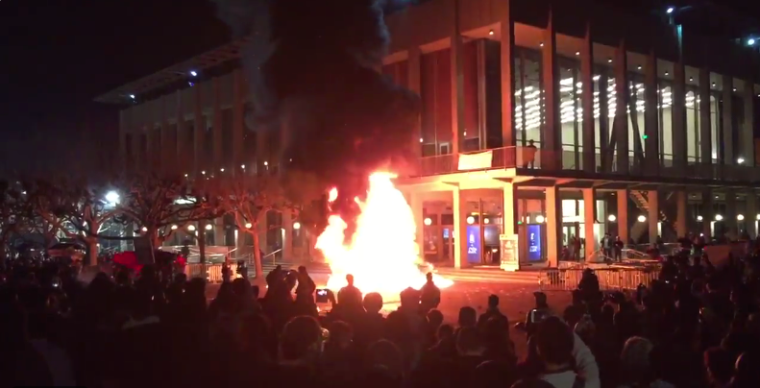What ability does the federal government have to influence higher education? Specifically, what policy levers exist for the federal government to punish an individual college or university? While I will not make a habit on the blog of responding to every higher education related tweet that President Trump sends out, his tweet regarding the University of California – Berkeley opens up a nice opportunity to discuss the role of the federal government in higher education and the limits of federal power over post-secondary education.

Following a series of protests that started to become violent on the Berkeley campus, the university cancelled a planned talk by Milo Yiannopoulos, a senior editor at the far-right website Breitbart News.
While the event and protests made national news, President Trump followed his pattern of pouring gasoline on the issue by tweeting:
If U.C. Berkeley does not allow free speech and practices violence on innocent people with a different point of view – NO FEDERAL FUNDS?
— Donald J. Trump (@realDonaldTrump) February 2, 2017
First, I don’t believe the President really believes that Berkeley should lose federal funding or that he has the authority to do so. This is another in a long line of blustery tweets that please his core supporters and agitate everyone else.
And to be crystal clear, there is no legal authority that a president holds that would allow the removal of federal funds from a college or university just because he decides he doesn’t like something the institution did the night before.
The tweet does raise some interesting questions regarding the ability of the federal government to influence higher education.
While the president does not have the power, it could be possible for Congress to grant the executive the authority to take away federal funds (a law that would no doubt be challenged in court by any college that were to face such a fate).
In fact, one of the major challenges that federal policy makers face in higher education policy unlike K-12 policy is that the levers available are simply much fewer and largely indirect.
The federal government does provide billions of dollars for higher education in the form of financial aid. However, this money is given to students and not institutions.
An easy way to think about this is the contrast with how states fund higher education. States provide direct appropriations for funding the operation and maintenance of the institution. The federal government largely gives financial aid to students that in turn pay institutions with the funds. The result of this funding approach is that in order to punish institutions you have to take away the ability of students to spend their financial aid at the institution. A decision which the federal government typically does not like to take as it is seen as punishing students as much if not more than institutions.
Grants and contracts are an exception to this as funding agencies do give money directly to institutions, but compared to financial aid this is a much smaller (though significant) piece of the finance puzzle.
The federal government can compel institutions to behave in certain ways or risk losing their funding. The most frequently cited case of this type of policy is what is known as the Solomon Amendment.
This legislation allows the federal government to deny grants to colleges and universities that do not allow military recruiters to recruit on campus. The constitutionality of the law was challenged and the Supreme Court unanimously upheld the law because it regulated behavior and not speech.
If Congress were to pass a law regulating the behavior of colleges related to how they deal with speech, this might be a way to regulate institutional decisions.
All of this means that Congress can attach strings to funding that they provide to colleges and universities. However, they are no allowed to change the terms after the fact. President Trump could get Congress to add a provision for federal funding for higher education that includes language regarding speech on campus and granting him the authority to take away funds if institutional behavior violated this type of stipulation (similar to military recruiters).
Yet, the Supreme Court is clear that retroactively adding requirements is not allowed as the President’s tweet seems to advocate.
Absent Congressional action, what options might the President have to influence institutional behavior?
The most likely lever would be the use of the Department of Education and the Office of Civil Rights.
This is a vehicle the Obama administration used quite effectively to influence how higher education dealt with the issue of sexual assault of campus. Trump could direct OCR to send out a “Dear Colleague” letter advising institutions on how to deal with speech issues on campus.
A “Dear Colleague” letter is quite influential and institutions would be forced to respond.
In the end, the options available to the President, particularly absent Congress, are quite limited to influence higher education.
The funding mechanisms, in particular, just don’t give the federal government nearly as much ability to influence higher education as other aspects of American life.
I would also be remiss if I didn’t acknowledge the fact that the leadership of the University of California – Berkeley handled the situation as well as could be reasonably expected. They made a case for free speech on campus, even if it was free speech that many disagreed with or found offensive. Only when safety concerns became overriding was the speech cancelled.
It would seem the university did exactly what President Trump and others have been calling on higher education to do: be more open to conservative voices. It is unfortunate that the President’s inability to control his 6am tweets has only contributed to bluster around this issue and obscured the strong response of the university.
In the end though, his tweet is bluster and does not change the fundamental dynamics of federal higher education policy or the ability of the federal government to influence institutional behavior.

